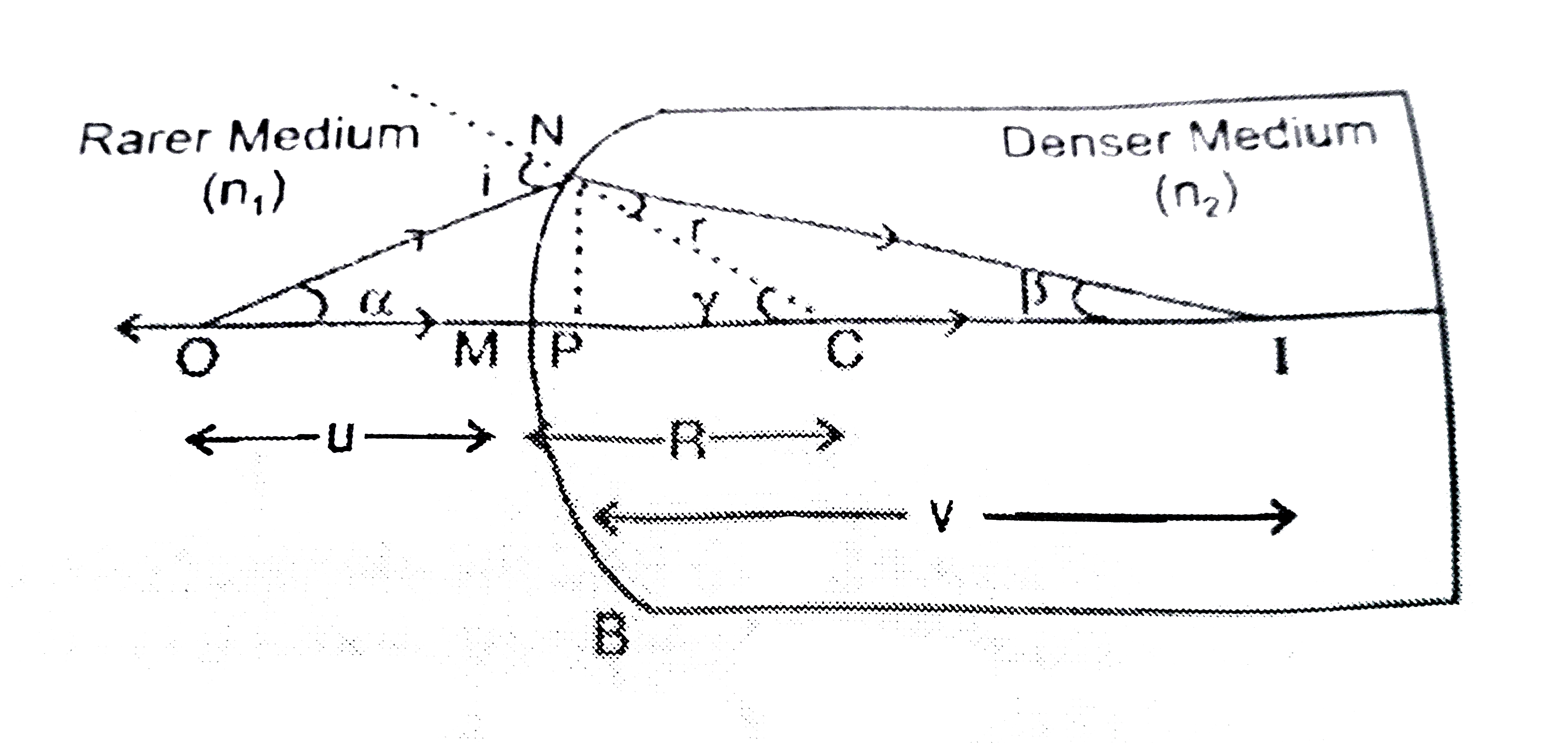(i) Device the mathematical n between refractive indices n1 and n2 of two radii and radius of curvature R for refraction at a convex shperical surface. Consider the object to be a point since lying on the principal axis in rarer medium of refractive index n1 and a real image formed in the denser medium of refractive index n2. Hence, derive lens marker's formula.
(ii) Light from a point source in air falls on a convex spherical glass surface of refractive index 1.5 and radius of curvature 20cm. The distance of light source from the glass surface is 100cm. At what position is the image formed ?

Let i be the angle of incidence of ray OA and r the anlge of refraction in the densor medium i.e, ∠OAN=i and ∠CAI=r. Let ∠AOP=a∠AIP=B and ∠ACP=b and ∠CPACP=y
In triangle OAC i=y+a
In triangle AIC, y=b+t or r=y−B
From Snell's law
If point A is very close to P, the angles i,r,a,b and c will be very small. Therefore
sini=i and sinr=r
From equation,
ir=n2n1
Sunstituting values of i and r , we get
γ+αγ−β=n2n1 or n1γ+αγ−β=n2n1 or n1=(γ+α)=n2(γ−β)
Let h be the height of perpendicular drawn from A on principal axis i.e. AM=h. As a,b and y are very small angles.
∴tanα=α, tanβ=β and tanγ=γ
Substituting these values,
n1(tanγ+tanα)=n2(tanγ−tanβ)
As point A is very close to point P, Point M is coincident with P.
From figure tanα=AMOM=hOP⇒tanβ=AMMI=hPI
tanγ=AMMC=hPC
Substituting these values , we get
n1(hPC+hOP)=n2(hPC+hPI) or n1(1PC+1OP)=n2(1PC+1PI)
If the distances of object O, image I, centre of curvature C from the pole be u,v and R respectively, then by sign convention PO is negative while PC and PI are positive. Thus,
u=−OP, v=+PI, R=+PC
Substituting these values in (vi), we get
n1(1R−1u)=n2(1R+1v) or n1R−n1R−n1u=n2R−n2u
n2v−n1u=n2−n1R
Topper's Solved these Questions
- XII BOARDSBOOK - XII BOARDS PREVIOUS YEARCHAPTER - XII BOARDSEXERCISE - SET-I (SECTION-A)
5 Videos
- XII BOARDSBOOK - XII BOARDS PREVIOUS YEARCHAPTER - XII BOARDSEXERCISE - SET-I (SECTION-B)
5 Videos
- XII BOARDSBOOK - XII BOARDS PREVIOUS YEARCHAPTER - XII BOARDSEXERCISE - Section-D
18 Videos
- SAMPLE PAPER 2019BOOK - XII BOARDS PREVIOUS YEARCHAPTER - SAMPLE PAPER 2019EXERCISE - SECTION D
6 Videos
Similar Questions
Derive the mathematical relation between refractive indices n1 and n2 of two media and radius of curvature R for refraction at a convex spherical surface. Consider the object to be a point one lying on the principal axis in rarer medium of refractive index nt and a real image formed in the denser medium of refractive index n2. Hence, derive lens maker's formula.
(ii) Light from a point source in air falls on a convex spherical glass surface of refractive index 1.5 and radius of curvature 20 cm. The distance of light source from the glass surface is 100 cm. At what position is the image formed ?
View SolutionA concave lens of refractive index 1.5 is immersed in a medium of refractive index 1.65. What is the nature of the lens ?
View Solution
Knowledge Check
When a lens of refractive index n1 is placed in a liquid of refractive index n2, the lens looks to be disappeared only if
An1=n22Bn1=34n2Cn1=n2Dn1=54n2Monochromatic light of wavelength λ1 travelling in medium of refractive index n1 enters a denser medium of refractive index n2. The wavelength in the second medium is
A(a) λ1(n1n2)B(b) λn2n1C(c) λ1D(d) λ(n2−n1n1)If the wavelength of light in vacuum be λ, the wavelength in a medium of refractive index n will be
AnλBλnCλn2Dnλ
A concave lens of refractive index 1.5 is immersed in a medium of refractive index 1.65. What is the nature of the lens ?
View SolutionWhen a lens of refractive index n1, then the lens looks to be dissapeared only, if
View SolutionA ray of light travels from a medium of refractive index n1 to
a medium of refractive index n2. If angle of incidence is i and
angle of refraction is r, than sinisinr is equal to
View SolutionIn a medium of refractive index n1, a monochromatic light of wavelength λ1 is travelling. When it enters in a denser medium of refractive index n2, the wavelength of the light in the second medium is
View SolutionLight travels from medium 1 (refractive index = n1) to medium 2 (refractive index = n2 ). If it is found that deviation d=r-i. We can say that
View Solution
